Voice over Internet Protocol (VoIP) technology is becoming increasingly valuable for charitable organizations, providing a cost-effective, scalable, and flexible communication solution.
By utilizing VoIP, nonprofits can streamline communication, cut operational costs, and allocate resources more efficiently to their core mission. This guide explains how VoIP technology can be used by nonprofits to enhance their impact and broaden their reach using VoIP phone services and their advantageous features.
Understanding VoIP technology for Nonprofit organizations
Voice over Internet Protocol, commonly known as VoIP, transforms the dynamics of how nonprofit organizations engage in communication.
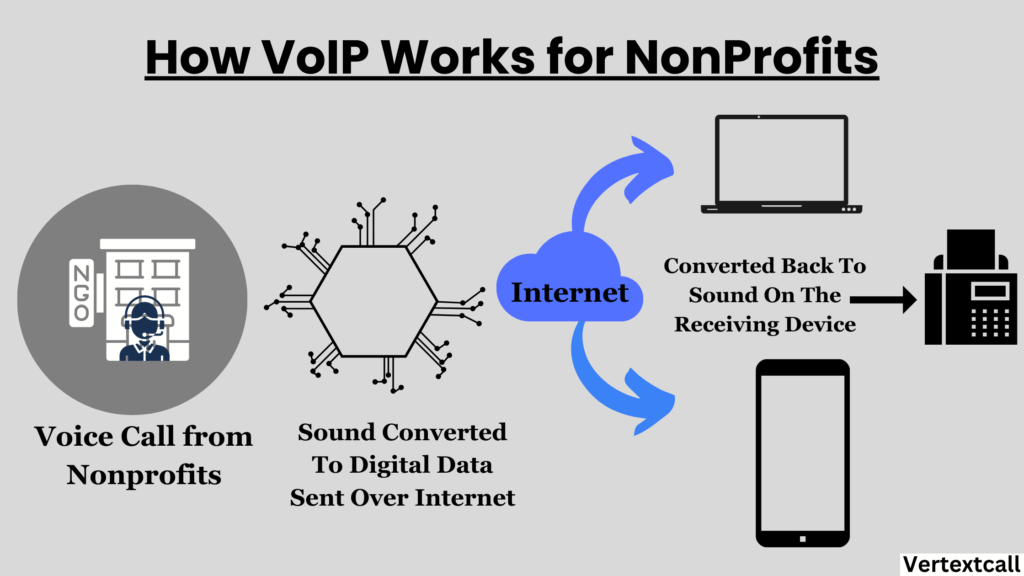
This technology enables Nonprofit organizations to use their internet connection for voice and other multi-media communications by transforming data into voice signals that are transmitted online.
Not only does this approach transform how charities interact with stakeholders and supporters, but it also offers a cost-effective substitute for conventional phone services.
Benefits of VoIP for Nonprofits
The integration of Voice over Internet Protocol (VoIP) offers various advantages to nonprofit organizations, playing a crucial role in advancing their efforts for greater impact. These benefits include:
1/ Cost Efficiency:
One of the most compelling benefits of VoIP technology is its ability to reduce operational costs. Unlike traditional telephony which often involves substantial hardware investment, maintenance costs, and expensive call rates, VoIP operates over the Internet.
This means your nonprofit organization can take advantage of lower call rates, including international calls, and significantly reduce the need for expensive telecommunication infrastructure.
2/ Fundraising and Donor Relations:
Effective communication strategies play an important role in nonprofit operations, especially in fundraising and donor relations. VoIP technology provides your organizations with advanced tools to enhance these critical areas.
By utilizing VoIP, nonprofits can establish advanced call routing to ensure potential donors are connected with the right person, thus improving the donor experience and increasing the likelihood of contributions.
Furthermore, VoIP’s integration with CRM systems simplifies updating donor information, recording interactions, and customizing communication based on individual preferences and history.
This develops a more personalized relationship between your organization and the donors, while significantly improving the efficiency and effectiveness of fundraising campaigns.
3/ Enhancing Volunteer Engagement and Coordination:
Effectively managing and engaging volunteers is crucial in nonprofit operations, just as handling donations. Implementing VoIP technology transforms volunteer coordination, creating a more organized, responsive, and engaged volunteer workforce.
Features like group calls and video conferencing help you communicate with team members, no matter where they are. This not only improves your planning and coordination of volunteer activities but also enhances your volunteers’ sense of connection and value, enhancing their motivation and commitment.
Additionally, utilizing VoIP systems allows nonprofits to easily host virtual meetings, share updates, and conduct training sessions without being limited by region.
4/ Facilitating Remote Work and Collaboration:
The ability to work remotely and collaborate across distances is essential for nonprofits. VoIP technology plays a crucial role in enabling this flexibility, ensuring better operations for your team no matter where they are.
With cloud-based conferencing, document exchange capabilities, and an instant messaging system, VoIP enhances productivity and engagement among your staff and volunteers.
This technology enables you to host virtual workshops, conduct brainstorming sessions, and manage projects while developing a collaborative culture.
Instant connectivity, idea sharing, and real-time document collaboration can significantly enhance your nonprofit’s ability to reach its objectives. Additionally, the cost savings from remote work options can be reinvested to further your nonprofit mission.
Related Reading: How VoIP phone solutions promote remote work
Key features of VoIP relevant to nonprofits
Below are some key features of VoIP that are particularly relevant to nonprofit organizations:
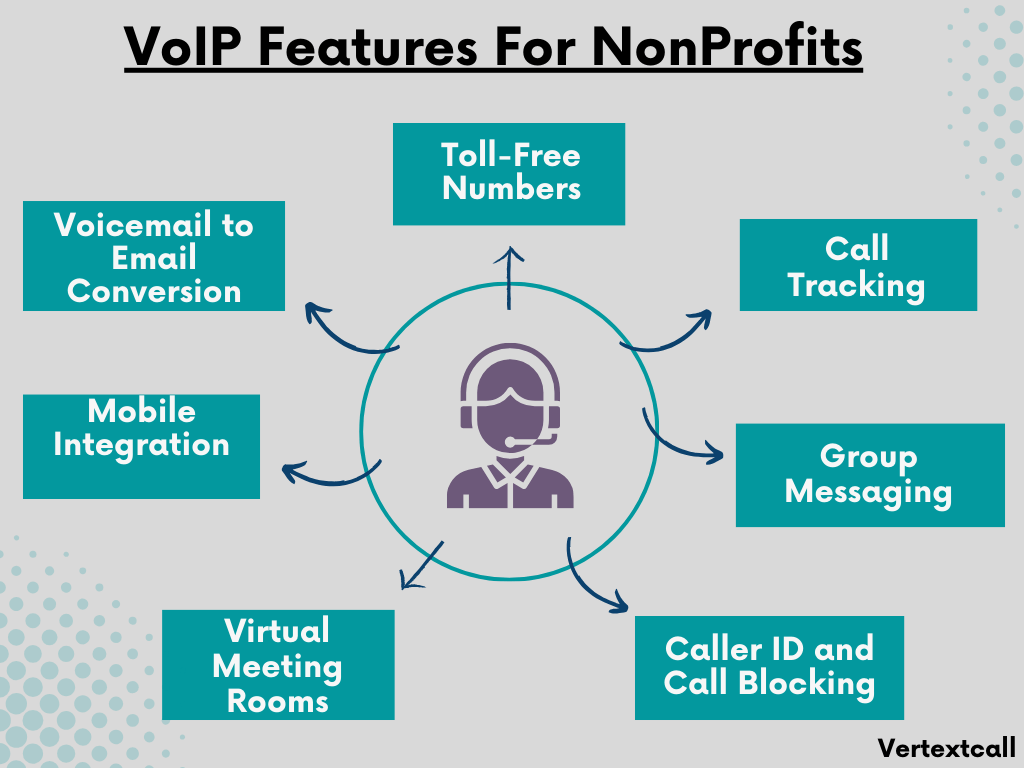
1/ Toll-Free Numbers for Donations:
Providing toll-free numbers is an impactful strategy for you if you’re a nonprofit looking to enhance your fundraising efforts. By utilizing VoIP services with toll-free numbers, your organization can offer potential donors a convenient and cost-free way to contribute.
This accessibility promotes more participation in charity by eliminating call charges that might discourage some donors. Not only does this approach increase donation levels, but it also broadens your donor base by appealing to a wider range of supporters.
Moreover, the use of toll-free numbers enhances your organization’s professionalism, building trust and credibility with current and potential donors.
2/ Call Tracking for Campaigns:
Implementing call tracking as part of your VoIP setup offers you a detailed analytical overview of your fundraising campaigns. This technology enables you to monitor and analyze call data, including the source, duration, and outcome of each call. Such insight is valuable for assessing the effectiveness of your specific campaigns or communication strategies.
By understanding which campaigns are generating the most engagement and donations, you can fine-tune your approaches for better results. Additionally, call tracking facilitates a deeper understanding of your donor behavior and preferences, allowing for more targeted and personalized communication efforts in the future.
3/ Group Messaging:
This feature enables you to efficiently share information, organize activities, and develop a sense of community among your volunteers. By actively involving volunteers in group messaging, you can demonstrate their importance and enhance their connection to the cause, enhancing their dedication and involvement.
Real-time communication through VoIP enables quick responses to changes or emergencies, improving the sharing of information with organizational goals. Additionally, utilizing group messaging not only enhances volunteer organization but also develops a motivated volunteer community, ultimately improving productivity.
4/ Caller ID and Call Blocking:
Another useful feature offered by VoIP technology is Caller ID and Call Blocking, which enables your nonprofit to efficiently manage inbound communications. With Caller ID, you can stay informed about incoming calls to prepare your team effectively. Meanwhile, Call Blocking helps you filter out unwanted calls, protecting your team from distractions and allowing them to concentrate on essential tasks.
5/ Virtual Meeting Rooms and Collaboration Tools:
These features allow your team to conduct meetings, share ideas, and work on documents together, regardless of each person’s physical location. With these features you can maintain an interconnected work environment, developing a culture of collaboration and unity within your nonprofit. This approach not only makes managing projects more efficient but also improves team morale and productivity.
6/ Mobile Integration:
Essentially, this feature turns every smartphone into an extension of your VoIP system, allowing you and your team to stay connected anytime, anywhere. Whether you’re in the field or working remotely, mobile integration ensures you remain in touch with your team and on top of your tasks. This constant connectivity is vital for nonprofits, particularly those with staff and volunteers spread across different locations.
7/ Voicemail to Email Conversion:
This feature converts your voicemail messages directly into emails, enabling you to manage communication more efficiently. You can access and respond to voicemails immediately without the need to continuously check your VoIP system for new messages.
By integrating voicemails into emails, nonprofit organizations can streamline their communication processes, ensuring that no important message gets missed out. Every call, whether from donors, volunteers, or partners, will be attended.
8/ Scalability:
VoIP systems can easily be scaled up or down based on the organization’s size and needs without significant additional costs, making it an adaptable solution for your nonprofits at different stages of growth.
Best VoIP service provider for Nonprofits
1/ RingCentral:
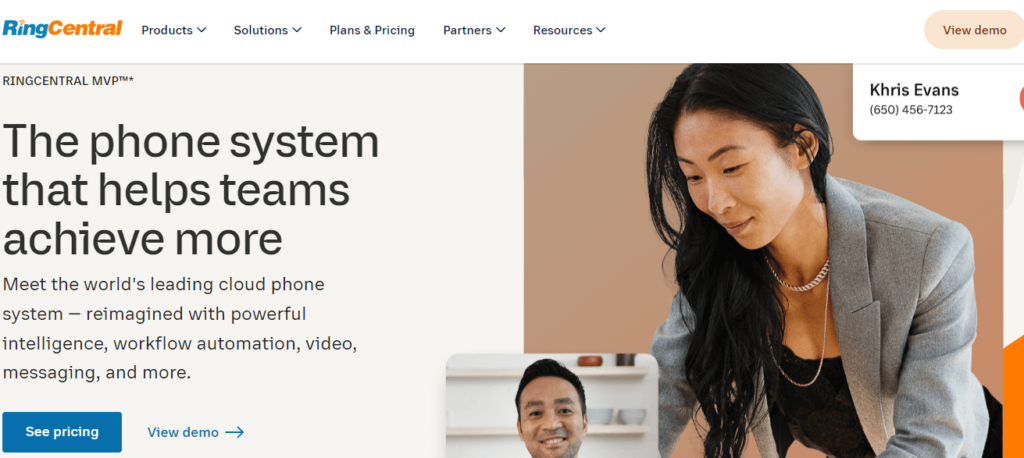
RingCentral stands out as a top VoIP service provider customized to meet the diverse needs of nonprofit organizations. It offers a wide range of features intended to improve communication and collaboration within your team. From advanced call management ensuring better interaction with stakeholders to comprehensive video conferencing capabilities promoting a stronger team connection among remote workers, RingCentral provides all the necessary tools for your nonprofit’s success.
RingCentral Features Overview:
- Advanced Call Management
- Comprehensive Video Conferencing
- Seamless Mobile Integration
- Team Messaging
- Security and Compliance
- File Sharing
- Screen Sharing
- Virtual Backgrounds
- Integration with Calendar Apps
Pricing Plans:
- Core: Starts at $30/user/month, offering basic VoIP functionalities.
- Advance: A step up, includes integrations, and costs approximately $35/user/month for nonprofits.
- Ultra: Enhanced features with advanced call handling; priced around $45/user/month.
2/ Nextiva:
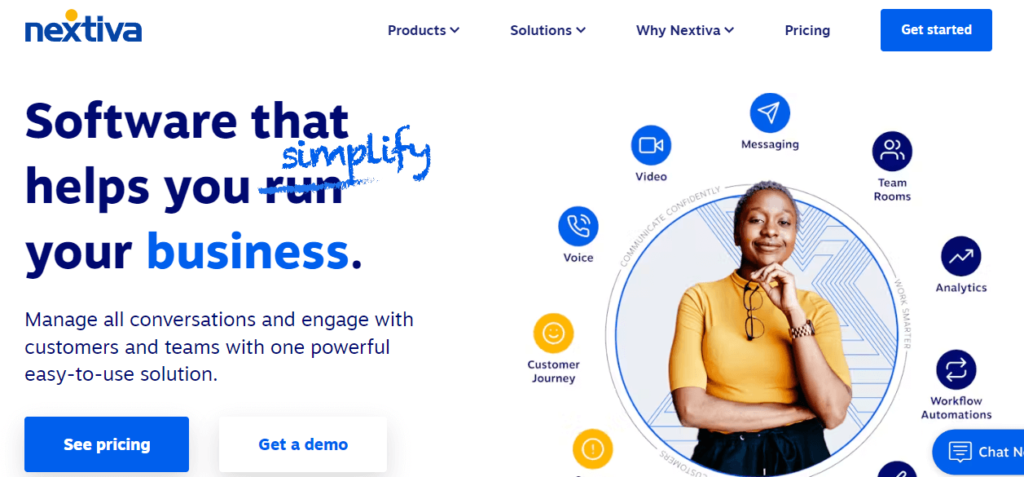
Another top VoIP service provider for nonprofits is Nextiva. With a focus on customer service, Nextiva offers 24/7 support and personalized training for new users. Its advanced features such as call recording, analytics, and voicemail-to-email conversion, make it an efficient communication solution for nonprofits of all sizes. Nextiva also offers mobile integration and a user-friendly interface, making it easy for staff and volunteers to stay connected and collaborate on projects.
Nextiva Features Overview:
- Advanced Call Management
- Voicemail to Email Conversion
- Mobile Integration
- Call Recording and Analytics
- Team Messaging
- Video Conferencing
- CRM Integration
- Customizable IVR
- Automated Call Routing
Pricing Plans:
- Essential Plan: Ideal for small teams with basic VoIP needs, starting at $30.95/user/month. Includes unlimited voice calling, free local/toll-free number, and 100 free domestic calling minutes.
- Professional Plan: Enhance communication with extra benefits, priced at $35.95/user/month. Offers unlimited conference calling, SMS messaging, and various collaboration tools.
- Enterprise Plan: For large nonprofits with advanced needs, the Enterprise plan is $45.95/user/month. Includes unlimited video calling, voice analytics, and advanced call management.
3/ 8×8:
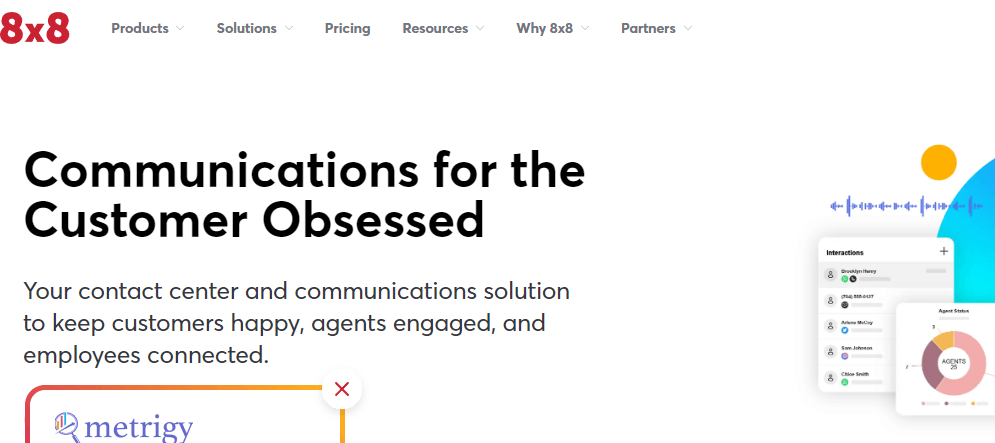
A reliable and cost-effective VoIP solution, 8×8 offers a range of features personalized for the unique needs of nonprofits. Its unlimited calling plans, advanced call management tools, and video conferencing capabilities make it a better option for organizations with a high volume of calls and remote workers. Additionally, its integration with popular CRM platforms enables efficient communication with donors and partners. 8×8 also offers a mobile app, ensuring that nonprofits can stay connected on the go.
8×8 Features Overview:
- Unlimited Calling Plans
- Advanced Call Management
- Video Conferencing
- Mobile App
- CRM Integration
- Voicemail to Email Conversion
- Virtual Office Analytics
- Call Recording
- Auto-Attendant
- Instant Messaging
- Presence Management
Pricing Plans:
- X Series X2: The beginning plan, includes unlimited calling to 14 countries and collaboration tools.
4/ Grasshopper:
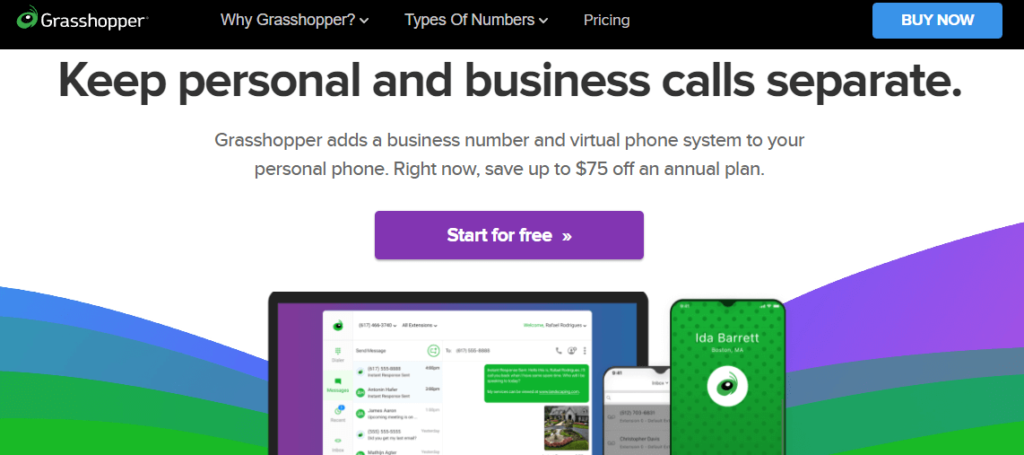
A simple and affordable VoIP service provider, Grasshopper caters to the communication needs of small nonprofits. Its virtual phone system allows for professional call management with features like auto-attendant and voicemail-to-email conversion. Grasshopper also offers an easy-to-use mobile app, making it convenient for staff and volunteers to stay connected and manage calls.
Grasshopper Features Overview:
- Auto-Attendant
- Voicemail to Email Conversion
- Call Forwarding
- Custom Greetings
- Mobile App
- Conference Calling
- Call Recording
- Virtual Fax
- Call Analytics
Pricing Plans:
- Solo: $14/month for 1 number and 3 extensions, ideal for small teams.
- Partner: $46/month for 3 numbers and 6 extensions, suitable for growing teams.
- Small Business: Provides 5 numbers and unlimited extensions at $80/month.
5/ Zoom Phone:
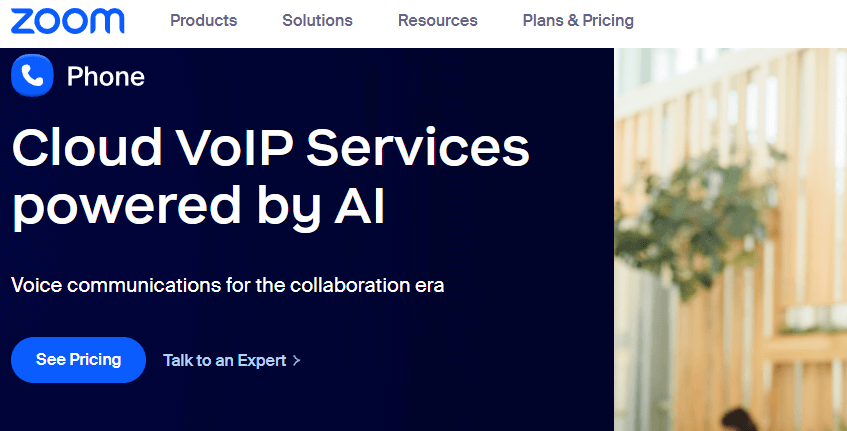
Zoom also offers a powerful VoIP solution known as Zoom Phone. Designed to simplify communication, Zoom Phone integrates with Zoom Meetings and Zoom Rooms, creating a unified platform for voice, video, and chat communications.
Its features include direct dialing with personal and company numbers, call forwarding, voicemail-to-text, and advanced call management. The global reach of Zoom Phone, combined with its ease of use and reliability, makes it a better choice for nonprofits looking to enhance their communication infrastructure with a familiar and trusted provider.
Zoom Phone Features Overview:
- Integration with Zoom Meetings and Rooms
- Direct Dialing (Personal and Company Numbers)
- Call Forwarding
- Voicemail-to-Text
- Advanced Call Management
- Global Reach
- User-Friendly Interface
- High Reliability
- Video Conferencing
- Call Recording
- Screen Sharing
- Customizable Hold Music
Pricing Plans:
- US & Canada Metered: $10/user/month plus pay-per-use calling rates.
- US & Canada Unlimited: At $15/user/month, offers unlimited calling within the US and Canada.
- Pro Global Select: Provides unlimited calling to 40+ countries for about $20/user/month.
Choosing the right service provider for Nonprofits
When assessing VoIP solutions for nonprofits, it’s crucial to align each option with the organization’s communication needs, budget, and operational strategies. Based on our experience here are the key considerations for selecting the ideal service provider:
- Feature Set: Ensure the VoIP solution offers a comprehensive set of features that support efficient communication and collaboration. Look for essential functions such as call forwarding, voicemail, video conferencing, mobile apps, and integration capabilities with existing tools.
- Cost Efficiency: Since nonprofits often operate under limited financial resources, it’s crucial to identify a provider that delivers value without compromising on quality or essential features. Carefully compare different pricing structures for any unnecessary costs or fees.
- Ease of Use and Setup: Choose a provider with user-friendly and accessible services to avoid the requirement for in-depth technical knowledge during setup and day-to-day tasks. This will facilitate a smoother adaptation period for staff and volunteers.
- Scalability: Choose a VoIP solution that can flexibly scale as your organization grows or as communication needs change, without requiring a complete system upgrade.
- Security and Reliability: Consider the security measures implemented by the provider to protect sensitive information and ensure a high level of service reliability with minimal downtime.
- Customer Support: Having access to informed and responsive customer support is crucial to ensure quick resolution of any technical difficulties and minimize any interruptions in communication.
- Integration Capabilities: Prioritize solutions that can easily integrate with existing CRM systems and productivity tools, streamlining workflows and enhancing efficiency.
Case study of Nonprofit organizations that have implemented VoIP
One example that highlights VoIP’s transformative impact in the nonprofit sector is the case of the Global Health Council (GHC), a nonprofit dedicated to improving healthcare access in underserved communities worldwide.
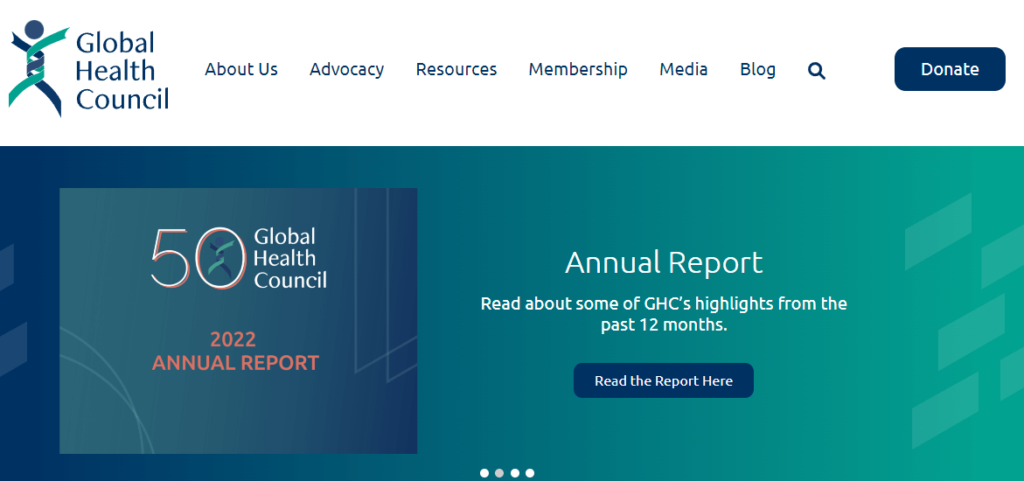
When they faced the challenge of coordinating a global network of volunteers, healthcare professionals, and donors, GHC turned to VoIP technology to upgrade its communication structure.
Before incorporating VoIP, GHC struggled with high communication costs and logistical problems in connecting its various stakeholders. The utilization of VoIP transformed GHC’s operations by enabling cost-effective, real-time communication across different time zones and locations.
The organization implemented a unified communication platform that integrated voice, video, and text messaging, promoting better collaboration among team members.
Frequently Asked Questions
Q1) Are there any free VoIP services?
Ans: Yes, there are free VoIP services available, but these typically come with limitations compared to paid subscriptions. Examples of free VoIP solutions include Skype, Google Voice, and WhatsApp. Free VoIP solutions often cater to individuals or very small teams, offering basic functionalities such as voice calling, call forwarding, and sometimes, limited video conferencing capabilities.
Q2) How much does VoIP cost for small businesses?
Ans: The cost of VoIP services for small businesses can vary depending on several factors, including the chosen provider, the feature set, the number of users, and any additional services required. On average, small businesses might expect to pay anywhere from $10 to $50 per user, per month.
Q3) What is the cheapest VoIP phone service?
Ans: One of the most cost-efficient VoIP phone services is Google Voice. It provides a no-cost option for individual users, offering features such as call recording, screen sharing, and voice and video conferencing over the Internet.

